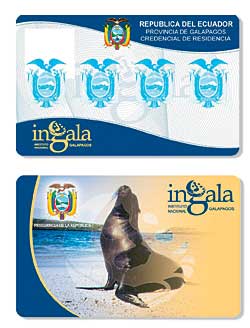The Last Word
Preserving Paradise
- By Brent Dirks
- Dec 01, 2006
 THANKS to being almost 1,000 miles away from any land mass, the Galapagos Islands on the Pacific Ocean are famous for the unique and self-supporting habitat that contains thousands of species of plants and animals native to the area.
THANKS to being almost 1,000 miles away from any land mass, the Galapagos Islands on the Pacific Ocean are famous for the unique and self-supporting habitat that contains thousands of species of plants and animals native to the area.
Made up of 19 volcanic islands of different sizes, the archipelago is probably most-famously known as Charles Darwin's study ground in 1835 for the theory of evolution presented in the 1859 The Origin of Species.
With the influx of people coming to the islands, Instituto Nacional Galapagos, the regulatory entity that handles the special care of the islands, wanted to use an identity card that couldn't be counterfeited.
Part of Ecuador, the drive to protect the ecological treasures on the island began in 1934 and culminated in 1959, when the Ecuadorian government and the United Nations Educational, Scientific and Cultural Organization (UNESCO) declared 97.5 percent of the region a national park. The islands were later deemed a World Heritage Site and granted Biosphere Reserve by UNESCO.
The 44,000-square-foot marine reserve surrounding the islands, containing some of the world's most unique aquatic life, is the second largest on the planet after the Great Barrier Reef of Australia.
The islands are home to more than 25,000 people while more than 150,000 tourists visit each year. It's popularity with tourists and would-be residents has spurred increased efforts by the Ecuadorian government and non-profit groups that study the islands to create a system that will protect the ecological treasures.
Technology Congruity
With the influx of people coming to the islands, Instituto Nacional Galapagos (INGALA), the regulatory entity that handles the special care of the islands, wanted to use an identity card that couldn't be counterfeited.
INGALA also wanted to rollout an identity card to help control local and foreign illegal immigrants on the islands. The country's constitution allows Ecuadorians to live on the islands only with special permission. Those who don't have permission are legalized or fined.
So, the Ecuadorian government turned to card printer and bar code labeling company Zebra, purchasing four P420i printers in order to control tourism and integration to the islands via secure, plastic identification cards.
The unit is able to print on the both sides of the card in full color at 300 dpi, producing up to102 cards per hour to meet the demands of the islands' identification system.
Featuring contactless smart card technology embedded in the card during production, the IDs will be issued to all Galapagos Islands residents and tourists. With contactless smart cards, instead of having to complete a physical scan, an RFID chip offers identity verification within proximity of a reader.
The resident security cards will include microtext security, invisible UV ink, a holographic overlay, photograph and bar code. Tourist cards will not include a photo and can be reused.
Information from both the resident and tourist cards will be stored in a computer database accessible between the islands, so even if a card is lost or stolen, the information can still be retrieved.
"The issue of the photo ID cards will be mandatory for all residents," said Frank Nankervis, manager of Ecuadorian-based Logikard, the integrator that sold the government the printers. "When tourists travel, the contactless cards will be used to check them the same way residents are checked. The cards will contain information about which islands the travelers are visiting, their passport number, how long they are allowed to stay and when they are leaving."
Nankervis said the government chose the technology because of the cards ability to be used in any place in the offline/secure mode and the database that ties into the cards.
"We chose contactless smart cards because communications between the islands are not very good, so we don't have a very trustworthy online system of communicating among the Galapagos Islands and the continent," Nankervis said. "So the chip card is one the main cards that can be used in an offline environment with the information being transmitted in batches."
The contactless smart cards also were chosen because the technology was less likely to be damaged by tourists walking on the beach or getting the cards wet. The durable cards also cannot be demagnetized like magnetic stripe technology.
Nankervis' company, along with SmartKard developed the software to issue and read the cards while controlling the flow of passengers in the Ecuadorian and Galapagos Island airports.
The Rollout
Tourists will surrender the cards when they leave the country. And if residents want to access reduced airfares offered to authorized citizens, they must show their identification card when leaving or entering the islands. This helps the previous problem when people would borrow identification cards from residents and use them to purchase the cheaper airfare.
The first step of the program -- issuing the ID cards to all residents of the islands -- is underway. In January, the cards will be issued to all tourists arriving through the Ecuador airport in order to verify if they have the permission to visit the islands and the length of their stay.
"So far, with the residents, the 'bad' ones do not want to be identified," Nankervis said. "But the program has strong support from the World Wildlife Fund, United Nations and other organizations."
And the island's program has caught UNESCO's attention. The organization is looking into using contactless smart cards to control access to some of the other 830 World Heritage sites across the globe.
This article originally appeared in the December 2006 issue of Security Products, pg. 84.